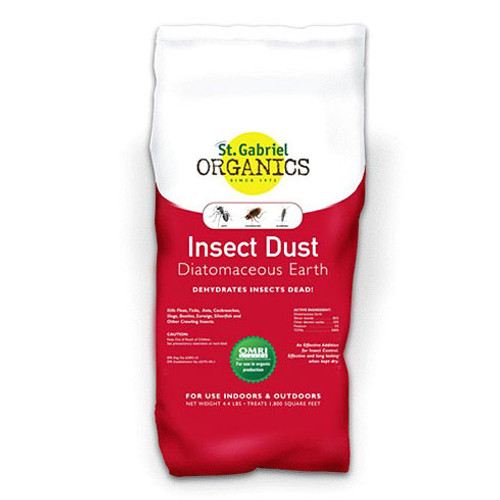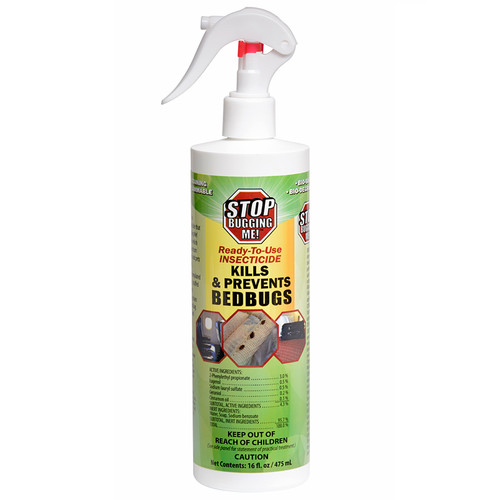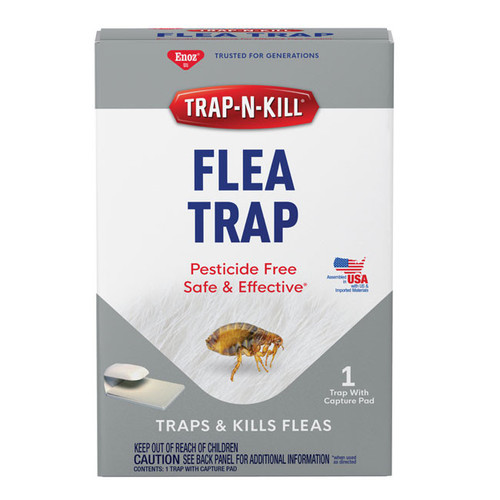
Shipping: ( Ships within 1 Business Day: Processing time varies: Learn more )
Bulk Pricing:
- Buy 2 or above and pay only $17.95 each
Overview
Use Insect Dust to eliminate crawling insects around your home. Our diatomaceous earth comes in the form of a chalky powder, and is the natural fossilized remains of diatoms, a type of hard-shelled algae. Diatom particles are very small and sharp – but only harmful to the small exoskeletons of insects. Insects cannot become immune to its action, as it is a mechanical killer – not a chemical one. Because it is a light dust, diatomaceous earth easily clings to the bodies of insects as they crawl over it. The tiny diatom particles then cut into the waxy coating of insects and they dry out and die of dehydration within 48 hours.
Food-Grade Diatomaceous Earth is an all-natural product that is so safe it can be sprinkled around your vegetable patch, or rubbed right into your dog's fur.
What Insects Does It Control?
- Fleas
- Ants
- Ticks
- Silverfish
- Cockroaches
- Bed bugs
- Carpet beetles
- Spiders
- Earwigs
- Spider mites
- House flies
- Slugs and snails
For Indoor Use:
Lightly coat a thin layer in areas where insects are found or may hide, such as kitchen cupboards, behind and under appliances, baseboards or drain pipes. For carpets, lightly sprinkle the Insect Dust over the carpet, and leave for 2-3 days before vacuuming.
You can leave the dust in place until you no longer see any signs of insects in that area, at which point you can clean it up.
Fleas
Thoroughly dust floor, carpets and bedding in and around pet's sleeping areas, as well as surrounding baseboards, cracks and crevices. Safe to use around your pets - it can be rubbed right into your dog's fur.
Bedbugs
Take apart bed and dust joints and channels. Dust any hollow tubing and the interior framework as well as the mattress and all cracks in the room. Use a turkey baster or duster to apply clouds of the dust over the affected area. Leave the dust for a few days. It is still safe to sleep in your bed even while the dust is present.
Silverfish
Lightly dust in and around kitchen and bathroom plumbing, along baseboards and wherever else silverfish are found.
Carpet Beetles
Dust along baseboards, carpet edges, under carpet, furniture and inside closets.
For Outdoor Use:
Lightly coat a thin layer of diatomaceous earth on areas where insects are found, such as patios, door frames, foundations, sewer pipes and drains. Apply as a barrier around plants, trees and garden beds. For best results, reapply the Insect Dust after heavy rainfall.
Flies
Thoroughly dust areas where flies frequent, such as livestock pens and kennels. It can be applied to livestock coat as an insect repellent/contact insecticide. DE can also be added to the food of pets and livestock. The DE helps as a de-worming agent for livestock, and it ends up in their dung. Flies lay eggs on the dung which hatch into maggots, which are then killed by the DE. This is an effective method for fly control, especially on farms and homesteads, and in outdoor areas where animals are present.
Fire Ants
Sprinkle diatomaceous earth directly on the ant mound, or mix with water to saturate the mound. It can also be sprinkled along ant trails. The ants will track the DE back to their nests where the colony will be exposed to its abrasive action.
Slugs and other garden pests
Apply as a barrier around plants and garden beds. Reapply after rain. Any diatomaceous earth that washes into soil will continue to benefit your garden, since it acts like vermiculite in retaining water for future slow release. Our diatomaceous earth is OMRI listed for organic use.
Diatomaceous earth will not harm worms or any of the beneficial microorganisms in the soil.
Lice control for chickens
Lice are a common scourge around chickens and can lower their vitality resulting in fewer eggs and disease. Set a "dusting box" of DE in the corner of the coop and chickens will continually apply themselves with DE. This will reduce or eliminate lice within a few days.
To purchase a dispenser tube, click here
Safety
This Food-Grade Diatomaceous Earth is uncalcined amorphous silica, which comes from natural freshwater deposits in the USA. The freshwater naturally occurring diatomaceous earth deposits that are designated Food Grade by the FDA have less than 1% crystalline silica. These deposits are primarily amorphous silica which is harmless when ingested and is commonly used in feed and food industries. Insect Dust is certified organic by the Organic Materials Review Institute.
Insect Dust is registered as an insecticide with the EPA, so it is required to have a generic health warning on the bag, despite its safety.
Environmental Health Coalition refers to Diatomaceous Earth as one of the least toxic insect controls on their "Home Safe Home" fact sheet about safe household cleaners and indoor pest control.
Professor Stuart Hill at McGill University describes Diatomaceous Earth as non-toxic and feeling like talc when you touch it. He says that if you are going to apply large quantities, you should wear a face mask to avoid inhaling it. However, he mentions that inhaling common road dust is probably more harmful than inhaling Diatomaceous Earth.
Please note that food-grade diatomaceous earth should not be confused with "pool grade" diatomaceous earth. Diatomaceous earth used in pool or water filtration contains DE that has been chemically treated and heated making the silica crystalline which is a dangerous respiratory hazard and harmful to the health of humans and animals.
Read our article Diatomaceous Earth: Non-toxic Pest Control for Your Home and Garden to learn more.
Description
Overview
Use Insect Dust to eliminate crawling insects around your home. Our diatomaceous earth comes in the form of a chalky powder, and is the natural fossilized remains of diatoms, a type of hard-shelled algae. Diatom particles are very small and sharp – but only harmful to the small exoskeletons of insects. Insects cannot become immune to its action, as it is a mechanical killer – not a chemical one. Because it is a light dust, diatomaceous earth easily clings to the bodies of insects as they crawl over it. The tiny diatom particles then cut into the waxy coating of insects and they dry out and die of dehydration within 48 hours.
Food-Grade Diatomaceous Earth is an all-natural product that is so safe it can be sprinkled around your vegetable patch, or rubbed right into your dog's fur.
What Insects Does It Control?
- Fleas
- Ants
- Ticks
- Silverfish
- Cockroaches
- Bed bugs
- Carpet beetles
- Spiders
- Earwigs
- Spider mites
- House flies
- Slugs and snails
For Indoor Use:
Lightly coat a thin layer in areas where insects are found or may hide, such as kitchen cupboards, behind and under appliances, baseboards or drain pipes. For carpets, lightly sprinkle the Insect Dust over the carpet, and leave for 2-3 days before vacuuming.
You can leave the dust in place until you no longer see any signs of insects in that area, at which point you can clean it up.
Fleas
Thoroughly dust floor, carpets and bedding in and around pet's sleeping areas, as well as surrounding baseboards, cracks and crevices. Safe to use around your pets - it can be rubbed right into your dog's fur.
Bedbugs
Take apart bed and dust joints and channels. Dust any hollow tubing and the interior framework as well as the mattress and all cracks in the room. Use a turkey baster or duster to apply clouds of the dust over the affected area. Leave the dust for a few days. It is still safe to sleep in your bed even while the dust is present.
Silverfish
Lightly dust in and around kitchen and bathroom plumbing, along baseboards and wherever else silverfish are found.
Carpet Beetles
Dust along baseboards, carpet edges, under carpet, furniture and inside closets.
For Outdoor Use:
Lightly coat a thin layer of diatomaceous earth on areas where insects are found, such as patios, door frames, foundations, sewer pipes and drains. Apply as a barrier around plants, trees and garden beds. For best results, reapply the Insect Dust after heavy rainfall.
Flies
Thoroughly dust areas where flies frequent, such as livestock pens and kennels. It can be applied to livestock coat as an insect repellent/contact insecticide. DE can also be added to the food of pets and livestock. The DE helps as a de-worming agent for livestock, and it ends up in their dung. Flies lay eggs on the dung which hatch into maggots, which are then killed by the DE. This is an effective method for fly control, especially on farms and homesteads, and in outdoor areas where animals are present.
Fire Ants
Sprinkle diatomaceous earth directly on the ant mound, or mix with water to saturate the mound. It can also be sprinkled along ant trails. The ants will track the DE back to their nests where the colony will be exposed to its abrasive action.
Slugs and other garden pests
Apply as a barrier around plants and garden beds. Reapply after rain. Any diatomaceous earth that washes into soil will continue to benefit your garden, since it acts like vermiculite in retaining water for future slow release. Our diatomaceous earth is OMRI listed for organic use.
Diatomaceous earth will not harm worms or any of the beneficial microorganisms in the soil.
Lice control for chickens
Lice are a common scourge around chickens and can lower their vitality resulting in fewer eggs and disease. Set a "dusting box" of DE in the corner of the coop and chickens will continually apply themselves with DE. This will reduce or eliminate lice within a few days.
To purchase a dispenser tube, click here
Safety
This Food-Grade Diatomaceous Earth is uncalcined amorphous silica, which comes from natural freshwater deposits in the USA. The freshwater naturally occurring diatomaceous earth deposits that are designated Food Grade by the FDA have less than 1% crystalline silica. These deposits are primarily amorphous silica which is harmless when ingested and is commonly used in feed and food industries. Insect Dust is certified organic by the Organic Materials Review Institute.
Insect Dust is registered as an insecticide with the EPA, so it is required to have a generic health warning on the bag, despite its safety.
Environmental Health Coalition refers to Diatomaceous Earth as one of the least toxic insect controls on their "Home Safe Home" fact sheet about safe household cleaners and indoor pest control.
Professor Stuart Hill at McGill University describes Diatomaceous Earth as non-toxic and feeling like talc when you touch it. He says that if you are going to apply large quantities, you should wear a face mask to avoid inhaling it. However, he mentions that inhaling common road dust is probably more harmful than inhaling Diatomaceous Earth.
Please note that food-grade diatomaceous earth should not be confused with "pool grade" diatomaceous earth. Diatomaceous earth used in pool or water filtration contains DE that has been chemically treated and heated making the silica crystalline which is a dangerous respiratory hazard and harmful to the health of humans and animals.
Read our article Diatomaceous Earth: Non-toxic Pest Control for Your Home and Garden to learn more.
- Key Feature:
- Safe, non-toxic diatomaceous earth for crawling insect control
- Origin:
- Made in the U.S.A.
- Coverage:
- 1800 square feet
- Weight:
- 4.4 lbs.
- Lead Time:
- Ships within 1 Business Day
- No-hassle, 30 day returns
- No sales tax
- Quick shipping
- Secure shopping (SSL, PCI, McAfee Secure)
- In business since 2000
- Member of Better Business Bureau, Green America, and US EPA Watersense
- Carbon-neutral, Family-owned business that promotes sustainability!
Product Videos
Specifications:
- Key Feature:
- Safe, non-toxic diatomaceous earth for crawling insect control
- Origin:
- Made in the U.S.A.
- Coverage:
- 1800 square feet
- Weight:
- 4.4 lbs.
- Lead Time:
- Ships within 1 Business Day











